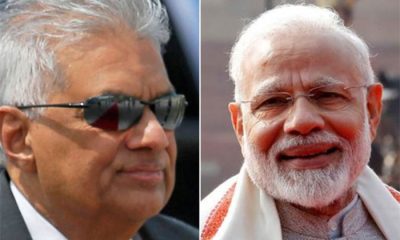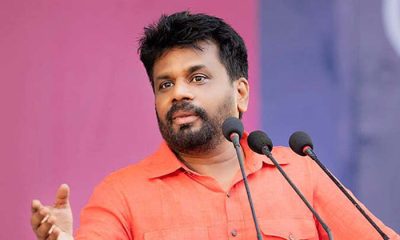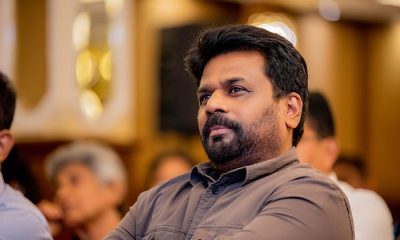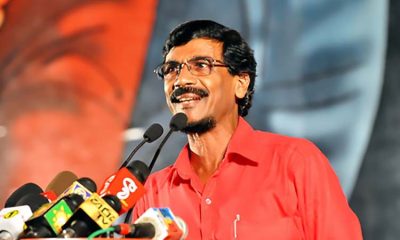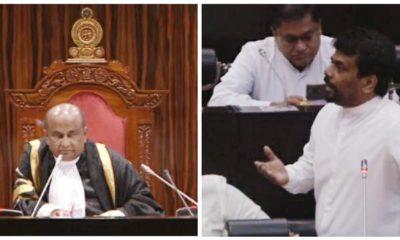Features
Asian Elections and Anura Kumara Dissanayake’s India visit
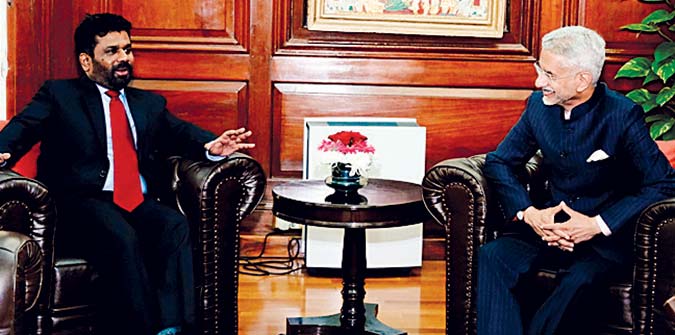
by Rajan Philips
2024 is election year practically everywhere. In South Asia, it is two down and two to go. Bangladesh went first in January, and the governing Awami League won the election as predicted, with the main opposition Bangladesh National Party boycotting the election and the government fielding independent candidates to avoid the embarrassment of winning uncontested seats. Pakistan had its election on February 8, and the people literally gave the finger to rebuke the military’s machinations of the election.
Unlike in Bangladesh, where the government nominated independent candidates, in Pakistan the imprisoned Imran Khan and his proscribed PTI (Pakistan Tehreek-e-Insaf) were forced to field their candidates as independents and were barred from using the Party’s Cricket Bat symbol. Yet they won the most seats, and they would apparently have won a clear majority but for the widely alleged manipulations in vote counting. There are continuing allegations by independent commentators that a clear victory for the PTI was stolen in the wee hours of the election night. In the aftermath of uncertainty, the former alliance of the Pakistan Muslim League of the Sharif brothers and the Bhutto-Zardari led Pakistan’s People’s Party, who ousted Imran Khan from office, is back – cobbling together yet another new government ignoring the people’s verdict.
Next up is India with the mother of all elections which will be held over two months in April and May. As things are, Prime Minister Modi is all set for a threepeat win and form a third Modi-BJP government in succession. The opposition parties are still haggling over how much of a united front opposition they can rationally build upon before it is too late. It seems already too late unless something spectacular were to happen to jolt the opposition fragments to come together to survive, let alone turn back the Modi juggernaut, or simply be run over by it as separate entities. What is more significant than the Modi threepeat is the way in which he is overhauling the character of the Indian state.
What Narendra Modi is doing now to India is what the leaders of Pakistan did to their country at the very moment of its cesarean birth – the creation of a theocratic religious state, spurning the example of India that opted for a modern secular state to overarch a deeply asecular traditional society, where religious differences were/are combustibly vulnerable to political demagoguery. We can keep writing about this till holy cows keep coming home, but the point here is that the recent and ongoing developments in Bangladesh, Pakistan and India provide an insightful South Asian backdrop to the anticipated elections in Sri Lanka, and perhaps more contextually to Anura Kumara Dissanayake’s seemingly geo-locally significant visit to New Delhi.
Sri Lanka is the fourth to go for elections in South Asia. But there was another Asian election this week, in Indonesia, the world’s fourth largest country, the third largest democracy, with the world’s largest Muslim population, and a growing economic powerhouse that is quite ahead of India in almost all economic growth measures. As in many other prospering countries, while there is impressive economic growth there is also a worrying democratic recession. In the presidential election on Wednesday (February 14), Prabowo Subianto, a former army lieutenant general of considerable notoriety under Suharto, and the current Minister of Defense under President Joko Widodo, is reported to be comfortably ahead to win in the first round without a runoff. His Vice Presidential running mate is 36 year old Gibran Rakabuming Raka, the eldest son of President Joko Widodo.
There has not been any reporting of serious voting malpractices, but pre-election shenanigans have raised concerns that the country is on the slippery slope of democratic recession. Joko Widodo and Prabowo Subianto are former rivals who faced off each other in the 2014 and 2019 presidential elections, which Joko won and Prabowo lost. They have since become allies and the highly popular Joko has gone to the extent of supporting Prabowo’s candidacy in 2024 against the nominee of his own Party (the ruling Indonesian Democratic Party of Struggle), Ganjar Pranowo, thereby ensuring Pranowo’s defeat. The alleged reasons for the switch are Joko’s political desire to continue to have a say in the government, and the even stronger paternal desire to give his son a stepping stone as the new Vice President. At 36, Gibran is underage to be Vice President, but the hurdle was removed by the country’s top court with Chief Justice Anwar Usman, Joko’s brother-in-law, casting the deciding vote for his nephew. What is new, and where?
Unlike other Asian countries, including Pakistan where the army calls all the shots, Sri Lanka is the only country where election timing is virtually at the discretion of its CEO, aka the Executive President. At the same time, an incumbent government’s interference in the conduct of elections would seem to have been minimized after 2015, and the first defeat of the Rajapaksas. One would hope that Mr. Ranil Wickremesinghe will not monkey with election timing anymore, and will not try to redeploy the old election dirty tricks of the UNP that go back all the way to Dedigama, long before independence, in the 1936 election to the second State Council election. The UNP was not a Party at that time, but its eventual fathers were in control of the levers of state power even under colonial rule.
AKD’s Visit
The only formal political party in Sri Lanka in 1936 was the Lanka Sama Samaja Party. By 1939, the Party was proscribed, and its leaders were jailed. They broke jail and went to India, not to escape incarceration, but to continue their revolutionary activity and join the struggle in India for freedom from colonial rule. The Indian expedition of the Old Left would be a more appropriate backdrop for commentary on the political implications of Anura Kumara Dissanayake’s visit to India than that cheap gossip in a Sunday Paper, about Lenin allegedly asking Trotsky to go even in a petticoat to procure peace at Brest Litovsk.
Many of the commentaries on the visit were also putt shots aimed at the pre-history of the NPP, or the old history of the JVP, and all of them predicated on the musings of Rohana Wijeweera about Indian Expansionism. Lionel Bopage, one of the repositories of the positive aspects of the JVP experience, has provided a useful overview of the evolution of the JVP’s position on India, but it is unlikely that the JVP’s and NPP’s media detractors would read Bopage or do their own research to provide an objective assessment of AKD’s visit to India.
One striking omission in almost all of the negative commentaries is that their negativity is singularly aimed at AKD and the JVP/NPP, and nothing much negative, if at all, has been said about the Modi government’s imperial invitation to a rising political star in India’s utmost isle. Yet I came across one amusingly innocent piece that politely accused India for its meddlesome manners especially in the matter of the Indo-Lanka Accord of 1987. There is nothing new in this, but what I found to be new is the nugget that Rohana Wijeweera apparently never stopped warning about India’s designs for Sri Lanka and that he based his premonitions on a detailed study of the Indian National Flag that includes The Ashoka Chakra or Dharma Chakra, and the Indian National Emblem that includes an adaptation of the four lions of Ashoka’s Lion Capital.
I don’t know whether Rohana Wijeweera actually said anything or believed that the use of the Chakra and the Lion in India’s national symbols is something that Sri Lankans should remain wary of. But this is the kind of nationalistic adolescence that Anura Kumara Dissanayake would hopefully help not only the JVP but also most Sri Lankans to grow out of, through the vehicle of the NPP. Thankfully, no one in the NPP is in the blabbering habit of Wimal Weerawansa, who once exhibited his high school general knowledge when he insisted in parliament that the Indian National Anthem, Tagore’s immortal rendition in Bengali, is only sung in Hindi! Those days are behind the Sri Lankan electorate, and there is much to look ahead.
Just on the question of the Chakra on the Indian Flag, there have been a few interpretations of it. Sarvapalli Radhakrishnan, the vocational Philosopher, India’s first Vice President and later President, has interpreted the Chakra as being representative of dharma and law. Prime Minister Nehru was more practical – the Chakra is symmetrical on the flag and easily reproduceable than Mahatma Gandhi’s Spinning Wheel that had been on the flag of the Congress during the independence struggle.
Sri Lankan Historian S. Arasaratnam, one of the more objective scholars of nationalism among Sri Lankan academics, has interpreted the Chakra as symptomatic of the efforts of India’s founding fathers (in the Constituent Assembly) to lift the emerging nation above the fray of its religious differences. Then comes along Modi after 75 years and plunges the country into a new temple triumphalism.
Those who ask the JVP to explain its rapprochement with India in light of its virulent opposition to the Indo Lanka accord 37 years ago, have not been consistent in asking others who too had been opposed to India in more ways than one and even long before the signing of the Indo Lanka accord.
NM Perera pithily characterized the foreign policy of DS Senanayake and the first UNP government as “Anglo mania and India phobia.” That mindset has been quite the norm in many political circles. It continued 30 years later with President Jayewardene at least until 1983. Even the SLFP has not been averse it to it despite later claims of a special relationship with the Nehru family in India.
As nuggets go, James Manor in his biography of SWRD Bandaranaike, The Expedient Utopian, recounts an anecdote from the 1930s, when Lord Mountbatten was stationed in Kandy and Nehru was visiting the island. Mountbatten suggested to one of SWRD Bandaranaike’s sisters that they should invite the visiting Indian leader for tea at Horagolla. Pat came the rebuff, “we do not sup with coolies.” That was more ignorance than snobbery, but the nugget would go down well in Modi circles in today’s India.
As well, as political analysis goes, one of the academic theses on the Indo Lanka Accord has been that the accord severed the linkages between the Sri Lankan state establishment and the social base of Sinhala Buddhist nationalism. The argument continued that what was ruptured in 1987 was restored only after 2005 when Mahinda Rajapaksa became President, thanks to the not so hidden hand support of the LTTE. Yet it has been a truism among Sinhala ultranationalists that Mahinda Rajapaksa is the only authentic Sinhala nationalist leader because everyone else was compromised by English.
Now that the Rajapaksas are gone, and the Supreme Court has ruled why, there might be revisitations of the old thesis. One hypothesis could be that the tragedy of the Rajapaksas is that they were used as dummies by others, who were otherwise political nobodies, for ventriloquistic claims on everything from nationalism to the economy, and from central banking to organic fertilizer.
As I wrote recently, the peacefully involuntary departure of the Rajapaksas has created the biggest vacuum to be filled in this election year. Anura Kumara Dissanayake has emerged as the most likely contender to fill that void, but in altogether different, and hopefully positive, ways. His trip to Delhi enhances that assessment, and even expectations, except for those who hold against Mr. Dissanayake the sins of his predecessors but will not subject any other political leader to such a demanding postmortem.
Features
The heart-friendly health minister

by Dr Gotabhya Ranasinghe
Senior Consultant Cardiologist
National Hospital Sri Lanka
When we sought a meeting with Hon Dr. Ramesh Pathirana, Minister of Health, he graciously cleared his busy schedule to accommodate us. Renowned for his attentive listening and deep understanding, Minister Pathirana is dedicated to advancing the health sector. His openness and transparency exemplify the qualities of an exemplary politician and minister.
Dr. Palitha Mahipala, the current Health Secretary, demonstrates both commendable enthusiasm and unwavering support. This combination of attributes makes him a highly compatible colleague for the esteemed Minister of Health.
Our discussion centered on a project that has been in the works for the past 30 years, one that no other minister had managed to advance.
Minister Pathirana, however, recognized the project’s significance and its potential to revolutionize care for heart patients.
The project involves the construction of a state-of-the-art facility at the premises of the National Hospital Colombo. The project’s location within the premises of the National Hospital underscores its importance and relevance to the healthcare infrastructure of the nation.
This facility will include a cardiology building and a tertiary care center, equipped with the latest technology to handle and treat all types of heart-related conditions and surgeries.
Securing funding was a major milestone for this initiative. Minister Pathirana successfully obtained approval for a $40 billion loan from the Asian Development Bank. With the funding in place, the foundation stone is scheduled to be laid in September this year, and construction will begin in January 2025.
This project guarantees a consistent and uninterrupted supply of stents and related medications for heart patients. As a result, patients will have timely access to essential medical supplies during their treatment and recovery. By securing these critical resources, the project aims to enhance patient outcomes, minimize treatment delays, and maintain the highest standards of cardiac care.
Upon its fruition, this monumental building will serve as a beacon of hope and healing, symbolizing the unwavering dedication to improving patient outcomes and fostering a healthier society.We anticipate a future marked by significant progress and positive outcomes in Sri Lanka’s cardiovascular treatment landscape within the foreseeable timeframe.
Features
A LOVING TRIBUTE TO JESUIT FR. ALOYSIUS PIERIS ON HIS 90th BIRTHDAY

by Fr. Emmanuel Fernando, OMI
Jesuit Fr. Aloysius Pieris (affectionately called Fr. Aloy) celebrated his 90th birthday on April 9, 2024 and I, as the editor of our Oblate Journal, THE MISSIONARY OBLATE had gone to press by that time. Immediately I decided to publish an article, appreciating the untiring selfless services he continues to offer for inter-Faith dialogue, the renewal of the Catholic Church, his concern for the poor and the suffering Sri Lankan masses and to me, the present writer.
It was in 1988, when I was appointed Director of the Oblate Scholastics at Ampitiya by the then Oblate Provincial Fr. Anselm Silva, that I came to know Fr. Aloy more closely. Knowing well his expertise in matters spiritual, theological, Indological and pastoral, and with the collaborative spirit of my companion-formators, our Oblate Scholastics were sent to Tulana, the Research and Encounter Centre, Kelaniya, of which he is the Founder-Director, for ‘exposure-programmes’ on matters spiritual, biblical, theological and pastoral. Some of these dimensions according to my view and that of my companion-formators, were not available at the National Seminary, Ampitiya.
Ever since that time, our Oblate formators/ accompaniers at the Oblate Scholasticate, Ampitiya , have continued to send our Oblate Scholastics to Tulana Centre for deepening their insights and convictions regarding matters needed to serve the people in today’s context. Fr. Aloy also had tried very enthusiastically with the Oblate team headed by Frs. Oswald Firth and Clement Waidyasekara to begin a Theologate, directed by the Religious Congregations in Sri Lanka, for the contextual formation/ accompaniment of their members. It should very well be a desired goal of the Leaders / Provincials of the Religious Congregations.
Besides being a formator/accompanier at the Oblate Scholasticate, I was entrusted also with the task of editing and publishing our Oblate journal, ‘The Missionary Oblate’. To maintain the quality of the journal I continue to depend on Fr. Aloy for his thought-provoking and stimulating articles on Biblical Spirituality, Biblical Theology and Ecclesiology. I am very grateful to him for his generous assistance. Of late, his writings on renewal of the Church, initiated by Pope St. John XX111 and continued by Pope Francis through the Synodal path, published in our Oblate journal, enable our readers to focus their attention also on the needed renewal in the Catholic Church in Sri Lanka. Fr. Aloy appreciated very much the Synodal path adopted by the Jesuit Pope Francis for the renewal of the Church, rooted very much on prayerful discernment. In my Religious and presbyteral life, Fr.Aloy continues to be my spiritual animator / guide and ongoing formator / acccompanier.
Fr. Aloysius Pieris, BA Hons (Lond), LPh (SHC, India), STL (PFT, Naples), PhD (SLU/VC), ThD (Tilburg), D.Ltt (KU), has been one of the eminent Asian theologians well recognized internationally and one who has lectured and held visiting chairs in many universities both in the West and in the East. Many members of Religious Congregations from Asian countries have benefited from his lectures and guidance in the East Asian Pastoral Institute (EAPI) in Manila, Philippines. He had been a Theologian consulted by the Federation of Asian Bishops’ Conferences for many years. During his professorship at the Gregorian University in Rome, he was called to be a member of a special group of advisers on other religions consulted by Pope Paul VI.
Fr. Aloy is the author of more than 30 books and well over 500 Research Papers. Some of his books and articles have been translated and published in several countries. Among those books, one can find the following: 1) The Genesis of an Asian Theology of Liberation (An Autobiographical Excursus on the Art of Theologising in Asia, 2) An Asian Theology of Liberation, 3) Providential Timeliness of Vatican 11 (a long-overdue halt to a scandalous millennium, 4) Give Vatican 11 a chance, 5) Leadership in the Church, 6) Relishing our faith in working for justice (Themes for study and discussion), 7) A Message meant mainly, not exclusively for Jesuits (Background information necessary for helping Francis renew the Church), 8) Lent in Lanka (Reflections and Resolutions, 9) Love meets wisdom (A Christian Experience of Buddhism, 10) Fire and Water 11) God’s Reign for God’s poor, 12) Our Unhiddden Agenda (How we Jesuits work, pray and form our men). He is also the Editor of two journals, Vagdevi, Journal of Religious Reflection and Dialogue, New Series.
Fr. Aloy has a BA in Pali and Sanskrit from the University of London and a Ph.D in Buddhist Philosophy from the University of Sri Lankan, Vidyodaya Campus. On Nov. 23, 2019, he was awarded the prestigious honorary Doctorate of Literature (D.Litt) by the Chancellor of the University of Kelaniya, the Most Venerable Welamitiyawe Dharmakirthi Sri Kusala Dhamma Thera.
Fr. Aloy continues to be a promoter of Gospel values and virtues. Justice as a constitutive dimension of love and social concern for the downtrodden masses are very much noted in his life and work. He had very much appreciated the commitment of the late Fr. Joseph (Joe) Fernando, the National Director of the Social and Economic Centre (SEDEC) for the poor.
In Sri Lanka, a few religious Congregations – the Good Shepherd Sisters, the Christian Brothers, the Marist Brothers and the Oblates – have invited him to animate their members especially during their Provincial Congresses, Chapters and International Conferences. The mainline Christian Churches also have sought his advice and followed his seminars. I, for one, regret very much, that the Sri Lankan authorities of the Catholic Church –today’s Hierarchy—- have not sought Fr.
Aloy’s expertise for the renewal of the Catholic Church in Sri Lanka and thus have not benefited from the immense store of wisdom and insight that he can offer to our local Church while the Sri Lankan bishops who governed the Catholic church in the immediate aftermath of the Second Vatican Council (Edmund Fernando OMI, Anthony de Saram, Leo Nanayakkara OSB, Frank Marcus Fernando, Paul Perera,) visited him and consulted him on many matters. Among the Tamil Bishops, Bishop Rayappu Joseph was keeping close contact with him and Bishop J. Deogupillai hosted him and his team visiting him after the horrible Black July massacre of Tamils.
Features
A fairy tale, success or debacle

Sri Lanka-Singapore Free Trade Agreement
By Gomi Senadhira
senadhiragomi@gmail.com
“You might tell fairy tales, but the progress of a country cannot be achieved through such narratives. A country cannot be developed by making false promises. The country moved backward because of the electoral promises made by political parties throughout time. We have witnessed that the ultimate result of this is the country becoming bankrupt. Unfortunately, many segments of the population have not come to realize this yet.” – President Ranil Wickremesinghe, 2024 Budget speech
Any Sri Lankan would agree with the above words of President Wickremesinghe on the false promises our politicians and officials make and the fairy tales they narrate which bankrupted this country. So, to understand this, let’s look at one such fairy tale with lots of false promises; Ranil Wickremesinghe’s greatest achievement in the area of international trade and investment promotion during the Yahapalana period, Sri Lanka-Singapore Free Trade Agreement (SLSFTA).
It is appropriate and timely to do it now as Finance Minister Wickremesinghe has just presented to parliament a bill on the National Policy on Economic Transformation which includes the establishment of an Office for International Trade and the Sri Lanka Institute of Economics and International Trade.
Was SLSFTA a “Cleverly negotiated Free Trade Agreement” as stated by the (former) Minister of Development Strategies and International Trade Malik Samarawickrama during the Parliamentary Debate on the SLSFTA in July 2018, or a colossal blunder covered up with lies, false promises, and fairy tales? After SLSFTA was signed there were a number of fairy tales published on this agreement by the Ministry of Development Strategies and International, Institute of Policy Studies, and others.
However, for this article, I would like to limit my comments to the speech by Minister Samarawickrama during the Parliamentary Debate, and the two most important areas in the agreement which were covered up with lies, fairy tales, and false promises, namely: revenue loss for Sri Lanka and Investment from Singapore. On the other important area, “Waste products dumping” I do not want to comment here as I have written extensively on the issue.
1. The revenue loss
During the Parliamentary Debate in July 2018, Minister Samarawickrama stated “…. let me reiterate that this FTA with Singapore has been very cleverly negotiated by us…. The liberalisation programme under this FTA has been carefully designed to have the least impact on domestic industry and revenue collection. We have included all revenue sensitive items in the negative list of items which will not be subject to removal of tariff. Therefore, 97.8% revenue from Customs duty is protected. Our tariff liberalisation will take place over a period of 12-15 years! In fact, the revenue earned through tariffs on goods imported from Singapore last year was Rs. 35 billion.
The revenue loss for over the next 15 years due to the FTA is only Rs. 733 million– which when annualised, on average, is just Rs. 51 million. That is just 0.14% per year! So anyone who claims the Singapore FTA causes revenue loss to the Government cannot do basic arithmetic! Mr. Speaker, in conclusion, I call on my fellow members of this House – don’t mislead the public with baseless criticism that is not grounded in facts. Don’t look at petty politics and use these issues for your own political survival.”
I was surprised to read the minister’s speech because an article published in January 2018 in “The Straits Times“, based on information released by the Singaporean Negotiators stated, “…. With the FTA, tariff savings for Singapore exports are estimated to hit $10 million annually“.
As the annual tariff savings (that is the revenue loss for Sri Lanka) calculated by the Singaporean Negotiators, Singaporean $ 10 million (Sri Lankan rupees 1,200 million in 2018) was way above the rupees’ 733 million revenue loss for 15 years estimated by the Sri Lankan negotiators, it was clear to any observer that one of the parties to the agreement had not done the basic arithmetic!
Six years later, according to a report published by “The Morning” newspaper, speaking at the Committee on Public Finance (COPF) on 7th May 2024, Mr Samarawickrama’s chief trade negotiator K.J. Weerasinghehad had admitted “…. that forecasted revenue loss for the Government of Sri Lanka through the Singapore FTA is Rs. 450 million in 2023 and Rs. 1.3 billion in 2024.”
If these numbers are correct, as tariff liberalisation under the SLSFTA has just started, we will pass Rs 2 billion very soon. Then, the question is how Sri Lanka’s trade negotiators made such a colossal blunder. Didn’t they do their basic arithmetic? If they didn’t know how to do basic arithmetic they should have at least done their basic readings. For example, the headline of the article published in The Straits Times in January 2018 was “Singapore, Sri Lanka sign FTA, annual savings of $10m expected”.
Anyway, as Sri Lanka’s chief negotiator reiterated at the COPF meeting that “…. since 99% of the tariffs in Singapore have zero rates of duty, Sri Lanka has agreed on 80% tariff liberalisation over a period of 15 years while expecting Singapore investments to address the imbalance in trade,” let’s turn towards investment.
Investment from Singapore
In July 2018, speaking during the Parliamentary Debate on the FTA this is what Minister Malik Samarawickrama stated on investment from Singapore, “Already, thanks to this FTA, in just the past two-and-a-half months since the agreement came into effect we have received a proposal from Singapore for investment amounting to $ 14.8 billion in an oil refinery for export of petroleum products. In addition, we have proposals for a steel manufacturing plant for exports ($ 1 billion investment), flour milling plant ($ 50 million), sugar refinery ($ 200 million). This adds up to more than $ 16.05 billion in the pipeline on these projects alone.
And all of these projects will create thousands of more jobs for our people. In principle approval has already been granted by the BOI and the investors are awaiting the release of land the environmental approvals to commence the project.
I request the Opposition and those with vested interests to change their narrow-minded thinking and join us to develop our country. We must always look at what is best for the whole community, not just the few who may oppose. We owe it to our people to courageously take decisions that will change their lives for the better.”
According to the media report I quoted earlier, speaking at the Committee on Public Finance (COPF) Chief Negotiator Weerasinghe has admitted that Sri Lanka was not happy with overall Singapore investments that have come in the past few years in return for the trade liberalisation under the Singapore-Sri Lanka Free Trade Agreement. He has added that between 2021 and 2023 the total investment from Singapore had been around $162 million!
What happened to those projects worth $16 billion negotiated, thanks to the SLSFTA, in just the two-and-a-half months after the agreement came into effect and approved by the BOI? I do not know about the steel manufacturing plant for exports ($ 1 billion investment), flour milling plant ($ 50 million) and sugar refinery ($ 200 million).
However, story of the multibillion-dollar investment in the Petroleum Refinery unfolded in a manner that would qualify it as the best fairy tale with false promises presented by our politicians and the officials, prior to 2019 elections.
Though many Sri Lankans got to know, through the media which repeatedly highlighted a plethora of issues surrounding the project and the questionable credentials of the Singaporean investor, the construction work on the Mirrijiwela Oil Refinery along with the cement factory began on the24th of March 2019 with a bang and Minister Ranil Wickremesinghe and his ministers along with the foreign and local dignitaries laid the foundation stones.
That was few months before the 2019 Presidential elections. Inaugurating the construction work Prime Minister Ranil Wickremesinghe said the projects will create thousands of job opportunities in the area and surrounding districts.
The oil refinery, which was to be built over 200 acres of land, with the capacity to refine 200,000 barrels of crude oil per day, was to generate US$7 billion of exports and create 1,500 direct and 3,000 indirect jobs. The construction of the refinery was to be completed in 44 months. Four years later, in August 2023 the Cabinet of Ministers approved the proposal presented by President Ranil Wickremesinghe to cancel the agreement with the investors of the refinery as the project has not been implemented! Can they explain to the country how much money was wasted to produce that fairy tale?
It is obvious that the President, ministers, and officials had made huge blunders and had deliberately misled the public and the parliament on the revenue loss and potential investment from SLSFTA with fairy tales and false promises.
As the president himself said, a country cannot be developed by making false promises or with fairy tales and these false promises and fairy tales had bankrupted the country. “Unfortunately, many segments of the population have not come to realize this yet”.
(The writer, a specialist and an activist on trade and development issues . )


